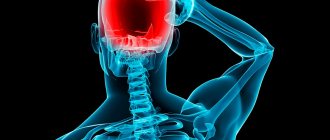Increased or decreased intracranial pressure (ICP) is accompanied by a number of negative symptoms, including dizziness, headache, loss of consciousness, which significantly worsens the quality of life. With the introduction of modern diagnostic imaging techniques, the diagnosis of increased intracranial pressure has become more common. However, in some cases, this diagnosis is not justified, since this is not an independent pathology, but serves as a concomitant sign of disease. How to measure intracranial pressure and which method is the most informative?
Definition and physiological norms of ICP
Intracranial pressure is the pressure that is formed in the cranial cavity under the influence of several anatomical structures, namely: blood volume, intracerebral fluid and brain tissue.
Normally, intracranial pressure indicators fluctuate within the following limits:
- in adults (3-15 mm Hg);
- in children aged 1 to 15 years (3-7 mm Hg);
- in newborns and children under 1 year (1.5 – 6 mm Hg).
These values are typical for people at rest, since during physical activity accompanied by muscle tension, a short-term increase in values up to 50-60 mm occurs. rt. Art. The phenomenon is due to the activation of compensatory mechanisms for adequate functioning of the central nervous system. Manifestations of increased cerebral pressure are diagnosed when compensatory mechanisms are disrupted when they cannot cope with the increase in values.
How to check intracranial pressure?
If a person suspects a change in intracranial pressure, he needs to know what signs accompany the syndrome and which doctor will help determine the disorder. Diagnosis of deviations in ICP indicators is carried out exclusively in medical institutions. Adults should consult a neurologist, since increased cerebral pressure can occur against the background of tumors, hematomas in the brain, and also develop against the background of a stroke and traumatic brain injury. As a rule, in adults, high ICP is a concomitant syndrome that occurs against the background of other diseases.
An examination in adults should be carried out if the following symptoms are observed:
Signs of intracranial pressure
- headache of a bursting nature without a specific localization;
- pain behind the eyeballs;
- increased intensity of headache in a horizontal position;
- attacks of nausea and vomiting not associated with food intake;
- severe weakness;
- changes in blood pressure;
- visual impairment.
Intracranial hypertension can be identified at home by the presence of the listed symptoms. With severe cerebral hypertension, patients experience fainting, speech dysfunction, chin tremor, panic attacks, and decreased heart rate.
Important! Diagnosis of increased intracranial pressure in children under one year of age is carried out during a routine examination by a neurologist. In most cases, neonatologists make a diagnosis of increased ICP, but in half of the infants it is incorrect.
Possible complications
If measures are not taken in time and the blood pressure level is not normalized, as the disease progresses, the symptoms will only worsen, causing serious complications. These include:
- damage to the cerebellum with partial or complete loss of coordination in space;
- disorders of speech and mental functions;
- arrhythmia, tachycardia, surges in blood pressure due to compression of the brain stem;
- loss of vision;
- the appearance of epileptic convulsive seizures, during which the patient’s breathing is depressed, the risk of cerebral edema and transition to a coma increases;
- paralysis.
Now it has become clear why intracranial pressure that is not subject to adequate treatment is dangerous. The benign form of intracranial hypertension occurs much more easily and without dangerous consequences; it is more often observed in women aged 20–40 years, taking oral contraceptives and being obese. The disease manifests itself as unsteadiness of gait, dizziness, morning sickness and signs of migraine.
When hormonal medications are discontinued and lifestyle is adjusted, it happens that the symptoms of the pathology may go away on their own. But it’s better not to hope that in a particular case the problem is caused by a benign form of hypertension; it’s worth starting to fight it right away.
Measurement principles
The principles of measuring intracranial pressure differ significantly from measuring blood pressure. To date, there are no devices for quickly measuring ICP. Since the structural elements located in the cranium occupy a certain volume of the cranial cavity, determined by its parameters, therefore it cannot change. Due to the fact that the volume of the cranial cavity cannot be changed, the ratio of brain structures is constant.
Measuring intracranial pressure is difficult because there are not enough indirect parameters by which to determine the pressure in the cranium. Depending on the diagnosis, age and functional state of the body, visual examination methods or modern research methods are used to diagnose patients, which make it possible to use equipment to determine the reasons that provoked changes in brain pressure. Invasive techniques through surgery are used to establish clear pressure values.
Modern methods of treatment
In some cases, the patient does not require treatment; he is observed and treated for the underlying disease, which caused the increase in ICP.
If it is necessary to treat pathology, two approaches are used - conservative and surgical.
Conservative interventions are carried out for those patients whose ICP elevation is chronic and there is no significant deterioration of the condition over time. The basis of treatment is drugs that have a diuretic effect, which reduce the volume of fluid in the head. The specific medicine is determined by the level of pressure and the situation. In severe and acute processes, osmotic diuretics (mannitol) are used, in chronic cases - furosemide, hydrochlorothiazide, spironalactone. While taking them, you need to drink a potassium preparation - Asparkam, Potassium orotate, Panangin.
Surgical methods for treating increased ICP depend on the stage and severity of the disease. In acute situations, craniotomy is performed to reduce fluid pressure on the brain and drain excess fluid. Special shunts (tubes) are installed as planned, which drain fluid from the brain into the abdominal cavity.
Non-invasive research methods
Non-invasive methods are used at the initial stage of diagnosis; measurements are carried out using external hardware systems. They make it possible to identify pathological changes in brain structures, as well as diagnose cranial pressure. Non-invasive techniques are safe and painless. However, the assessment of indicators is indirect, since the data obtained as a result of the examination may be mistakenly taken for signs of increased ICP, namely the expansion of the interventricular gap and the ventricles themselves. These methods are necessary to establish the reason that provoked the change in indicators.
Fundus examination is the most informative method of non-invasive monitoring of intracranial hypertension
To identify increased cranial pressure in a clinic, a specific algorithm is used, including the following methods:
- Fundus examination. Detection of swollen optic discs in the fundus and expansion of the vascular network are signs of pathology that require additional research. In the absence of pathological changes, additional techniques are not required, since ICP is within normal limits.
- Tomography, ultrasound of the brain. They allow you to determine the cause of the disorder, but do not determine the exact amount of cranial pressure.
- Electroencephalography. Determines changes in brain electrical activity, indicating an increase in ICP indicators (chaotic excitation of structural elements of the brain, formation of high-frequency rhythms, diffuse changes).
- Otoacoustic examination. The technique is carried out through the ears. With cerebral hypertension, blood pressure values in the inner ear increase.
- Transcranial Dopplerography. Blood pressure is measured by determining the decrease in blood flow velocity resulting from the development of cerebral hypertension.
The results obtained during the studies do not provide an accurate picture of the indicators of cerebral hypertension; they are used to establish the primary diagnosis of the disease.
What to do if the above symptoms appear?
If there are signs of the disease, you should consult a neurologist. To treat a pathological condition, it is necessary to find out its exact cause. That is why the doctor prescribes a set of diagnostic procedures:
- Fundus examination. Allows you to identify swelling of the optic nerve - one of the main signs of intracranial hypertension.
- Echoencephalography is an ultrasound procedure for examining brain tissue. Such diagnostics will help confirm or refute the presence of a tumor, cyst, hemorrhage, or other pathological changes in tissue structure. This diagnostic method does not require preparation, changes in daily routine or nutrition.
- X-ray of the skull. Prescribed for suspected birth defects, fractures or bone displacement. This method also identifies possible tumors that are causing compression.
- CT or MRI of the head. The most accurate and informative diagnostic methods. They allow you to thoroughly assess the condition of bones, soft tissues, and blood vessels. As a rule, the doctor prescribes such a diagnosis after echoencephalography, if it shows the presence of a pathological process.
- Ultrasound of the vessels supplying the brain. It is necessary to identify possible anomalies, tortuosities, and thromboses.
- Angiography. Allows you to visualize large and small vessels and detect areas of affected arteries.
The purpose of the above procedures is to determine the cause of the malaise. Based on the examination results, the specialist prescribes additional diagnostics or decides on treatment.
Invasive methods for monitoring ICP
To accurately diagnose cerebral hypertension, invasive methods are used; they are carried out through surgery, when a special sensor is inserted into the cranial cavity through a burr hole. The procedure is carried out in a hospital equipped with the necessary equipment. During the examination, there is a high risk of injury to the brain and spinal cord, so this method is used in extreme situations that require immediate confirmation of the diagnosis.
You can measure cerebral pressure using an invasive method if you have the following indications:
- intracranial hemorrhage;
- stroke;
- hydrocephalus;
- meningitis of an infectious nature;
- posthypoxic encephalopathy.
Important! Thanks to cerebral pressure monitoring, it is possible to coordinate perfusion pressure, which reflects the effectiveness of cerebral hemodynamics, and also makes it possible to evaluate the results of decongestant therapy.
Depending on the location of the drainage system, indicators are measured using the following techniques:
- intraventricular;
- intraparenchymal;
- subdural;
- subarachnoid.
Intraventricular technique
The earliest method of cranial pressure control. The main advantage is the possibility of drainage of cerebrospinal fluid and direct endolumbar administration of medications.
External ventricular drainage
The procedure for measuring ventricular pressure is carried out using a strain gauge. The technique is easy to interpret the results and does not require the use of expensive equipment. This procedure is not only diagnostic, but also therapeutic, since it allows you to control cranial pressure by draining the cerebrospinal fluid.
Parenchema method
During the study, the sensor is installed through the trefination hole in the parenchyma of the medulla to a depth of no more than 2.5 cm. This method is preferable, since the data obtained during the study are more consistent with the readings of intraventricular pressure.
Epidural technique
Direct technique for monitoring ICP using sensors. The technique is based on the introduction of special devices into the cerebral ventricles, which make it possible to measure cerebral pressure values to set accurate pressure.
The following examination systems are used:
- Microsensory. The tensor apparatus is introduced into the required brain area, after which the information converted into electrical signals is reflected on the monitor.
- Fiber optic. Additionally, a drainage system is connected, which allows a moderate reduction in cerebral pressure values.
- Pneumatic. A catheter with a latex balloon filled with air is installed.
Diagnostic methods for children
As a rule, cranial pressure in a child can be determined using neurosonography (ultrasound), which is performed through the fontanel. This examination is safe and painless. It is used to examine young children and allows you to accurately determine the functional state of the ventricles of the brain. An increase in their volume is a sign of increased intracranial pressure.
Neurosonography procedure in young children
In older children, when the fontanelle has already closed, computed tomography and magnetic resonance imaging are used to visualize brain structures. Studies make it possible to establish the blood supply of blood vessels, the state of liquorodynamics and the presence of neoplasms.
Today, an echoencephalogram is also widely used, with the help of which most indicators are assessed, including the pulsation of cerebral vessels. During the study, the amplitude of oscillations of the ultrasonic signal is taken as a basis, due to which the ICP is assessed. The disadvantage of the method is the inaccuracy and unreliability of the results obtained.








